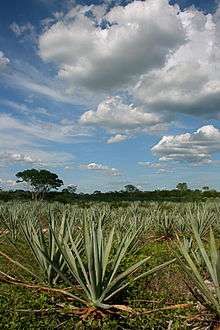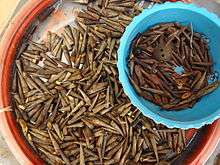Henequen industry in Yucatán
Henequen industry in Yucatán Peninsula is an agribusiness of a plant native to Yucatán, Mexico. After extraction from the plant, henequen is processed as a textile in various forms to obtain a range of products for domestic, commercial, agricultural and industrial use,[1] as binder twine for crops such as hay. Until the mid-20th century, it was a major industrial activity, the mooring of vessels depending on it. Its decline is attributed to the industry size, its socio-economic impact, as well as the invention of synthetic fibers and the manufacturing from these of substitute products which displaced henequen and sisal fibers. In addition to its fiber, the juice extracted from the henequen plant has been industrialized as a liquor similar to tequila. Also derived from its juice are certain steroidal chemicals used in the pharmaceutical industry.


Etymology
The English term agave was known in the Mayan languages as ki. Henequen (Agave fourcroydes) was referred to as henequen blanco by the Spaniards and sakki by the Mayan, while sisal (Agave sisalana,) was henequen verde to the Spaniards and yaxqui to the Maya.[2]
Land preparation in the 19th century
Just before the rainy season sets in the vegetation — dry as tinder from the rays of a tropical sun that having beaten down on it for months — is burned off. The drenching rains of the wet season mingle the ashes with the soil, which is all the fertilizing it needs. Then at the opening of the next season, sometimes after a second light burning off, the ground is divided into mecates, or spaces about 75 square feet (7.0 m2). To each worker are given so many mecates to plant daily. He makes a series of holes, very shallow, in the burned soil about 8 feet (2.4 m) apart in each direction, and in these holes places a bud or cutting of a henequen plant. Each mecate then contains from 80 to 100 plants. The holes are not made with a shovel or hoe, but with a stout stick shod with a sharp iron point, and the holes are frequently mere excavations in the soft, friable, limestone rock. The workers work at planting very swiftly, and in an incredibly short time a vast extent of territory is planted. During the whole of the first season, and especially toward the close of the rains, the newly planted ground has to be kept clear. This work is done with the machete. In less than three years, the plants are so large that further care is unnecessary, and in from five to seven years they begin to yield. The plants then are nearly 6 feet (1.8 m) high, and bear a great number of stout leaves from 4–5 feet (1.2–1.5 m) long. They continue bearing for 20 years. The edges of these leaves are provided with innumerable sharp thorns, sickle or fish-hook shaped, and the point of the leaf is prolonged into a black, very sharp spike or thorn-like.[3]
Production
The henequen is first cut from the stem quite near the ground, then carried to the mill where it is torn into shreds by machinery, and then hung upon rails in the sun to dry, after which it is put up in bales which are compressed by machinery. The whole process is at once simple and effective, and a great quantity may be baled in a single day. The henequen arrives at maturity, or at a point ready for cutting, in from five to seven years. The leaves, when at their best, are from 4–5 feet (1.2–1.5 m) in length. Each plant yields 20 or 30 leaves yearly for a period of 12 to 20 years, about a third more in the rainy than in the dry season. It takes over 8,000 leaves to make a 400-pound bale. The bales vary in weight from 350 to 450 pounds each.[4]
The period of 1880 to 1915 are considered to be the henequen boom years. In 1873, it exported 31,000 bales; 1879, 113,000 bales; 1884, 261,000; 1904, 606,000; and in 1915, 1.2 million bales were exported.[5] The production of henequen in 1900 was 500,000 bales; in 1914, the production was 1,026,000 bales; in 1918 the production had declined to 805,000 bales.[6] At the beginning of the 20th century, there were 87,000 hectares (210,000 acres) planted in henequen. This reached an all-time high — more than 70% of all cultivated land in Yucatán — in 1916 with 202,000 hectares (500,000 acres).[5]
History
In 1898, when the Spanish–American War broke out, the price of fiber advanced rapidly. The supplies of Manila hemp were interrupted on account of the war conditions in the Philippine Islands, and that caused an advance in the price of henequen to about US$0.10 or $0.12 a pound. That sudden advance in the price brought great wealth to Yucatán and it immediately took first rank among the Mexican States. Shortly after 1900, the State of Yucatán showed very rapid strides in education, sanitation, and in the general improvement in the well being of the people. That price, which was high at that time, brought about a boom in Yucatán and the usual consequences of a boom followed, so that there were from 1907 until 1911 a few mild panics brought about by speculation and over-extension not only by the banks but by various commercial firms.[7] The henequen industry was established on a very solid and profitable basis. The state whose only product, or whose only source of revenue, was henequen, became one of the richest States in the Republic of Mexico. At the time of Salvador Alvarado's entry into Yucatán it was the richest State in the Republic of Mexico. The planters received an average price of about US$0.05 per pound for their fiber. There were various buyers and exporters of henequen in Yucatán up until 1915, when Alvarado drove them out. When Alvarado reached Mérida, he seized the railways of the State. In 1912, shortly after the inauguration of the first military governor, Nicolás Camára Vales, an organization was made of various henequen planters in conjunction with the government of the State. This organization was named the Comision Reguladora del Comercio del Henequen (CRMH), commonly known as the Reguladora. The purpose of that organization was to regulate the henequen industry -— that is to say, that when in the operation of the law of supply and demand any large accumulation of henequen took place, the Reguladora was to take this accumulation off the market and hold it until such time as the demand caught up with the supply. The governor of Yucatán was always president ex-officio of the Reguladora. The Reguladora functioned with more or less success but played no important part in the commercial or economic life of Yucatán. When Alvarado assumed power in 1915, he assumed charge of the Reguladora, appointed his own board of directors, and gave notice that he was to arrange that the Reguladora would be the only institution or firm allowed to deal in henequen in Yucatán. Following out this policy, he ordered his director of the railways to refuse to transport any henequen shipped by anybody except to the consignment of the Reguladora.[8]
See also
| Wikimedia Commons has media related to Henequen industry in Yucatán. |
References



- Pérez de Sarmiento & Savarino Roggero 2001.
- Evans 2013, p. 35.
- Farm Implement News Company 1894, p. 14.
- Baker 1895, p. 21.
- Evans 2013, p. 40.
- Fall 1920, pp. 891.
- Fall 1920, p. 874.
- Fall 1920, p. 875.
Bibliography
- Baker, Frank Collins (1895). A Naturalist in Mexico: Being a Visit to Cuba, Northern Yucatan and Mexico (Public domain ed.). D. Oliphant. p. 21.CS1 maint: ref=harv (link)
- Evans, Sterling D. (14 January 2013). Bound in Twine: The History and Ecology of the Henequen-Wheat Complex for Mexico and the American and Canadian Plains, 1880-1950. Texas A&M University Press. ISBN 978-1-62288-001-0.CS1 maint: ref=harv (link)
- Fall, Albert Bacon (1920). Investigation of Mexican Affairs: Preliminary Report and Hearings of the Committee on Foreign Relations, United States Senate, Pursuant to S. Res. 106, Directing the Committee on Foreign Relations to Investigate the Matter of Outrages on Citizens of the United States in Mexico (Public domain ed.). United States. Congress. Senate. Committee on Foreign Relations, U.S. Government Printing Office.CS1 maint: ref=harv (link)
- Farm Implement News Company (1894). Farm Implement News. 15. Chicago, Illinois.CS1 maint: ref=harv (link)
- Pérez de Sarmiento, Marisa; Savarino Roggero, Franco (2001). El cultivo de las élites: grupos económicos y políticos en Yucatán en los siglos XIX y XX. Consejo Nacional para la Cultura y las Artes. ISBN 978-970-18-5419-8.CS1 maint: ref=harv (link)
Further reading
- Chardon, Roland Emanuel Paul (1961). Geographic Aspects of Plantation Agriculture in Yucatan. National Academies. pp. 142–. NAP:11330.
- Marichal, Carlos; Frank, Zephyr (18 July 2006). "Reports of Its Demise Are Not Exaggerated: The Life and Times of Yucatecan Henequen". From Silver to Cocaine: Latin American Commodity Chains and the Building of the World Economy, 1500–2000. Duke University Press. pp. 300–. ISBN 0-8223-3766-5.